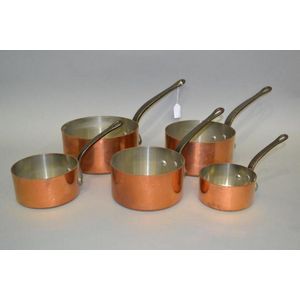Floral Old Sheffield Plate Decanter Coasters
You must be a subscriber, and be logged in to view price and dealer details.
Subscribe Now to view actual auction price for this item
When you subscribe, you have the option of setting the currency in which to display prices to $Au, $US, $NZ or Stg.
- Embossed / Repousse - Embossing, also known as repousse, is the technique of decorating metal with raised designs, by pressing or beating out the design from the reverse side of the object.It is the opposite of chasing, where the decoration is applied from the front. An embossed or repoussed object may have chasing applied to finish off the design.
- Sheffield Plate - Sheffield plate was the first commercially viable method of plating metal with silver. The method of plating was invented by Thomas Boulsover, a Sheffield Cutler, in 1743 and involved sandwiching an ingot of copper between two plates of silver, tightly binding it with wire, heating it in a furnace and then milling it out in to sheet, from which objects could be made.
Originally used by its inventor to make buttons, the potential of the material was quickly realised, and soon it was being used to fashion boxes, salvers and jugs, and not long after that candlesticks and coffee pots, and other traditional tableware.
Although there was a considerable saving in the amount of silver used, Old Sheffield Plate manufacture was more labour intensive than solid silver, meaning higher labour costs. This meant that Old Sheffield Plate was very much a luxury product, and only available to the very wealthy.
The thickness of the silver means that many 18th century Sheffield Plate pieces still have a good layer of silver, while electroplated pieces (EPNS), may have been replated several times over their lifetime. Where the silver has worn off the Sheffield plate the soft glow of the copper base can be seen underneath. However this is not an infallible guide that the piece is Sheffield Plate, as many EPNS items were also plated on to a copper base.
Most Sheffield plate items are unmarked, whereas most elecroplated items display manufacturers names or marks, quality indications such as "A1", "EP", together with pattern or model numbers.
Sheffield plate was made commercially between 1750 and 1850. - Boxwood - Boxwood is a hard, yellow coloured, close grained timber. In the 19th century it was often used for inlays, especially stringing, because of its contrasting colour to the darker timbers of the carcase. Stringing is the inlay of a narrow strip of veneer of a lighter colour, such as boxwood along or close to the edges of an object that has been veneered in a darker timber such as mahogany.
Because of its fine grain and resistnce to splitting or chipping it has also been used for treen, turnings, carvings and other small wooden items, such as chess pieces.
This item has been included into following indexes:
Visually similar items

American mahogany king size sleigh bed comprising of 2 ends and 2 rails

Set of five French copper saucepans (5)

14ct yellow gold and green jade brooch, weight: approx 3.9 grams, size: approx 4 cm wide (tested as 14ct)

A quality precious stone set spray brooch, 18ct white gold hallmarked Cb, designed as a floral spray brooch, detailed by varied size round floral clusters, each set with a brilliant cut diamond bezel set, framed by round rubies, emeralds or sapphires, all
